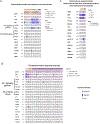Lineage plasticity in cancer: a shared pathway of therapeutic resistance
- PMID: 32152485
- PMCID: PMC7397755
- DOI: 10.1038/s41571-020-0340-z
Lineage plasticity in cancer: a shared pathway of therapeutic resistance
Erratum in
-
Publisher Correction: Lineage plasticity in cancer: a shared pathway of therapeutic resistance.Nat Rev Clin Oncol. 2020 Jun;17(6):382. doi: 10.1038/s41571-020-0355-5. Nat Rev Clin Oncol. 2020. PMID: 32203275
Abstract
Lineage plasticity, the ability of cells to transition from one committed developmental pathway to another, has been proposed as a source of intratumoural heterogeneity and of tumour adaptation to an adverse tumour microenvironment including exposure to targeted anticancer treatments. Tumour cell conversion into a different histological subtype has been associated with a loss of dependency on the original oncogenic driver, leading to therapeutic resistance. A well-known pathway of lineage plasticity in cancer - the histological transformation of adenocarcinomas to aggressive neuroendocrine derivatives - was initially described in lung cancers harbouring an EGFR mutation, and was subsequently reported in multiple other adenocarcinomas, including prostate cancer in the presence of antiandrogens. Squamous transformation is a subsequently identified and less well-characterized pathway of adenocarcinoma escape from suppressive anticancer therapy. The increased practice of tumour re-biopsy upon disease progression has increased the recognition of these mechanisms of resistance and has improved our understanding of the underlying biology. In this Review, we provide an overview of the impact of lineage plasticity on cancer progression and therapy resistance, with a focus on neuroendocrine transformation in lung and prostate tumours. We discuss the current understanding of the molecular drivers of this phenomenon, emerging management strategies and open questions in the field.
Figures


References
Publication types
MeSH terms
Substances
Grants and funding
LinkOut - more resources
Full Text Sources
Medical
Research Materials
Miscellaneous

